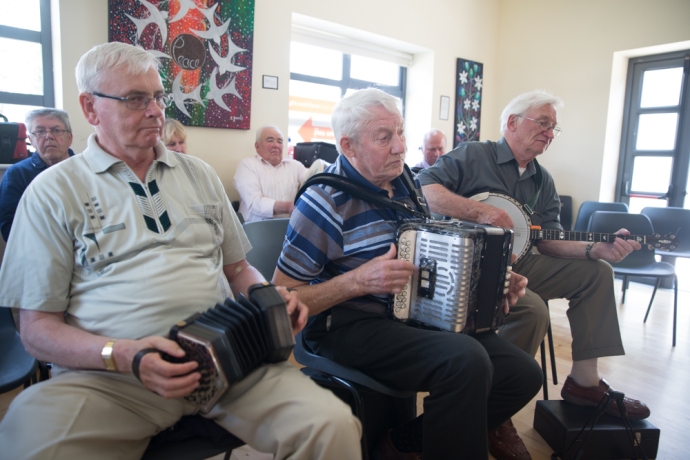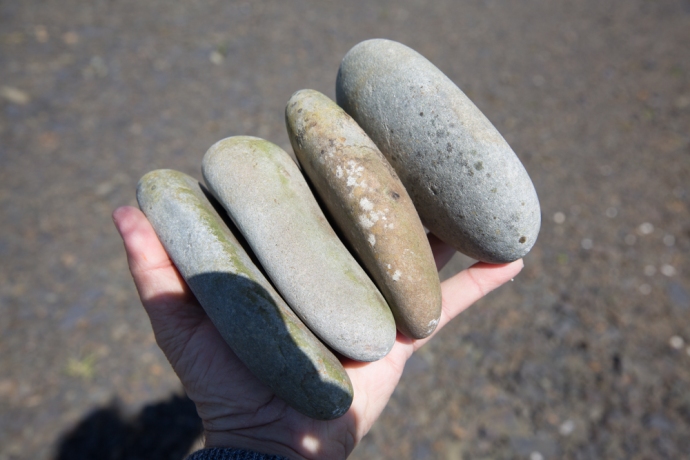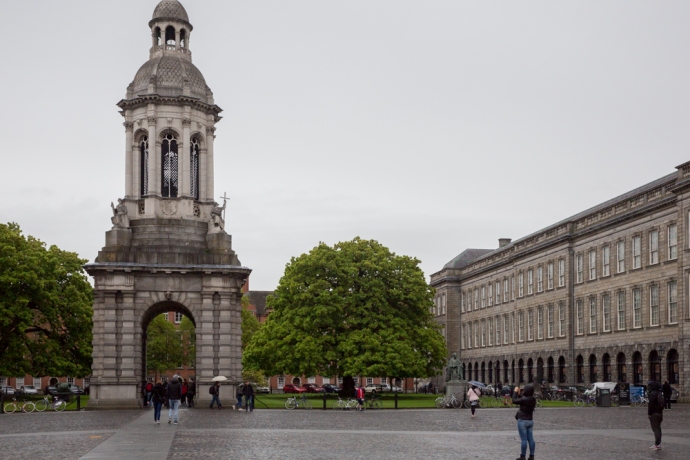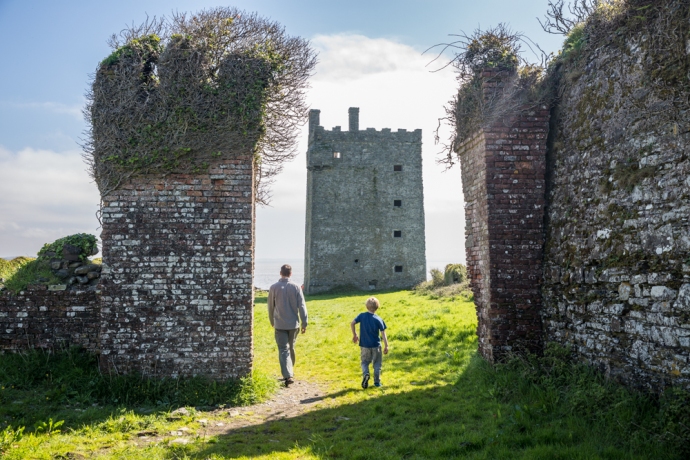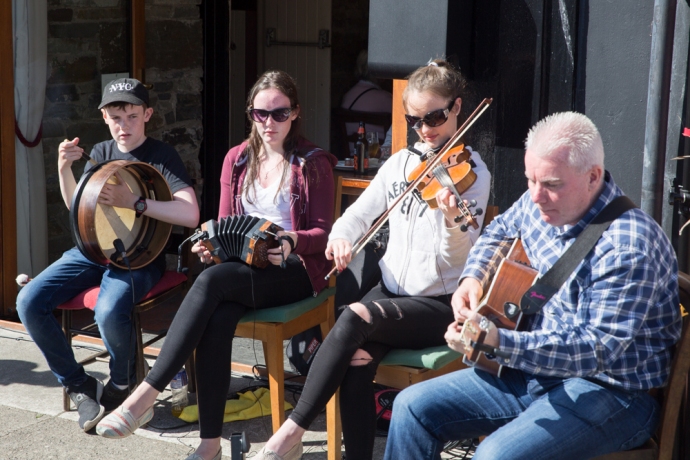At the southern end of West Clare, on an island just off the coast near the town of Kilrush, lies one of country’s best kept secrets. But that’s changing. The word is out. Last year it was awarded a prestigious European Destination of Excellence award for Ireland for offering a ‘tangible cultural experience’ and visitor numbers are dramatically increasing. In 2016 870 people visited the island. This year they are expecting up to 6,000 people.
Before 2016 visiting the island was unpredictable. If there was enough interest then a boat trip was organised. That changed with the setting up of Scattery Island Tours two years ago. They have just commissioned a spanking new ferry that comfortably accommodates 70 against the old one, which took 12, and this is certainly helping but don’t let that put you off. I spoke to Irene Hamilton, one of the principals of the company, about the her desire to open the island to a larger audience and at the same time preserve what it is that makes it special. The island has so much to offer and you can tailor the experience to your own needs. Join a guided tour and have the stories of the island explained or explore on your own.
Irene comes from a line of island residents. Her father was born on the island and was a sea pilot as was his father. This link and the remarkable foresight of the people of Kilrush has put the Company at the forefront of placing Scattery as one of the must-see destinations of Clare. Her vision is that visitors don’t just zip past on the way to Loop Head but stop overnight in Kilrush and explore the place at leisure.
So why is it special? There’s actually nothing else like it. A now uninhabited island with a continuous occupation that started over 1,500 years ago, beautifully preserved, easily accessed and in a spectacular location.
I had been trying on and off for a while to get onto the island but it just never happened. During an unusual warm spell in late May I tried again. The Gods were smiling this time and on a bright blue Thursday I boarded the An Breandàn for the short trip across the channel from Kilrush. Irene told me that the boat was named for her father and it is no coincidence that Breandàn is also the patron saint of the sea.

Boarding the ferry to Scattery
Actually the most time consuming part of the journey was in the lock at the entrance to the Marina. It was fascinating to see the water rush in as the gates opened to maintain the level in the Marina

Water enters the lock

Irene Hamilton, owner of the ferry company chats to patrons.
Once through the lock you see the island and its signature Round Tower rapidly approach you and in less than 15 minutes you are there. We were well looked after by the efficient and friendly crew which included Irene’s sister Martina. Irene was a mavellous host spending much of the time, when she wasn’t performing seafaring duties, chatting with patrons and and answering questions or helping with family photos or making cups of tea.

Approaching the island. The Round Tower dominates.

The view from the pier, The white cottage on the left is the Visitor Centre, Keane’s Castle is in the centre and the Round Tower can be seen in the distance.
When we arrived we were handed over to Michael who acted as our guide. The guides are provided by OPW who manage the island. They also maintain a small visitor centre. The tour is roughly an hour and you visit all the monastic and archaeological sites with the exception of the lighthouse and the Battery. This was certainly worth it as Michael has a wealth of background knowledge that fleshed out the story. Next time however I will explore it on my own but I would certainly recommend the tour as a first time experience. And anyway it’s included in the price of the ticket.

The guided tour begins
The story of Scattery starts with the birth of St Senan, in 488AD in Molougha, a townland about 5 km from Kilrush in Co Clare. After a life of religious study including time in Rome he set up a monastery on Inis Cathaig in 532AD. This is the original Irish name and over time it became anglicised as Scattery. The name relates to the presence of a monster known as the “The Cathach” which was said to inhabit the island. On Senan’s arrival he apparently faced the monster and ordered it, in the name of the Trinity, to depart. Such was Senan’s power that The Cathach obeyed and retreated to Doolough Lake at the foot of Mount Callan.
Little is known of Senan’s life or life under him in the monastery. Many miracles are attributed to him however and his grave has continued to hold a sacred place among the people of West Clare and beyond. The grave is supposed to be the site of miraculous cures. Stones from St. Senan’s Bed were regarded as relics and a protection against diseases and especially drowning. Water from St Senan’s Well had restorative powers.
We do know his rule on the monastery was austere and women were banned from even setting foot on the island. St Senan died in 544, but it would appear that the monastery continued unimpeded until the arrival of the Vikings in Ireland in 795. Scattery which lay on their route to Limerick was sacked between 816 and 835, being severely damaged. In 968 the Vikings were expelled from Limerick by Brian Boru and retreated to Scattery. Boru however pursued them and three years later the island was raided with up to 800 people being slaughtered.
In 1057 the Vikings had another go with the Dublin Danes plundering the island. Then again in 1101 Magnus, king of Norway attacked. The Normans arrived in 1176 and this led to an attack by William Howell, not even sparing the churches. By 1189 the last Bishop of Scattery had died and the Diocese of Scattery was abolished. The English now took possession of the island. The end came however following the 1537 introduction of the Suppression of the Monastries Act by Henry VIII.
Phew! That is some story. It seems to have been touched by every major historical event that Ireland experienced. There are many reminders of this tortured time in the ruins that can be seen on Scattery. Churches that date back as far as the 8th century, the round tower built between 10th and 12th century, St Senan’s well, St Senan’s Bed. I found this all totally absorbing. Come with me on a virtual tour.

St Mary’s Cathedral and Oratory. Built in 8th Century and added to until the 15th century. The Round Tower in the distance.

The eastern window of the Cathedral. The carved stone head is said to be St Senan.

View of the Cathedral from the west.

Western doorway of the cathedral. Note the tapered shape of the door under the heavy lintel. The stone to the left is thought to be a balaun stone.

A distant view of the Round Tower and the Cathedral.

The Round Tower built between 8th and 10th Century. Note the unique doorway at ground level

View from inside the Round Tower
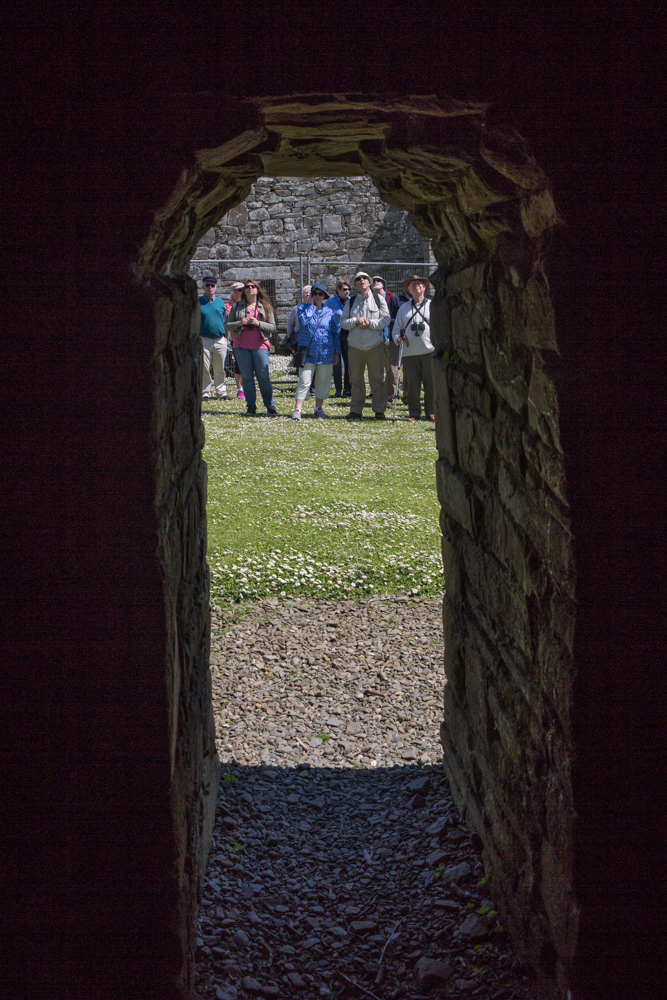
The Round Tower doorway. Note the thick walls; over 1 metre.

St Senan’s Well. During a drought St Senan prayed for water and an angel guided him to this spot. The Sanit plunged his staff into the ground and water sprung forth.

Distant view of Cnoc an Aingeal (Hill of the Angel), One of the earliest surviving churches built on the site where Senan set foot on the island.

Remaining early wall of the church on Cnoc an Aingeal.

St Senan’s Church. 12th Century Romanesque style

St Senan’s Bed, a small church built over the grave of St Senan. The iron bar is supposedly designed to keep women from walking in. Women who entered according to tradition will be cursed

View of the Round Tower from the entrance to St Senans Church

A stone table found near St Senans Church. Thought to be a medieval grave slab carved with a beautiful celtic cross and with an inscription saying Or Do Moenach Aite Mogroin. (Pray to Moenach the teacher of Mogroin).

Teampall Na Marbh (Church of the Dead). Built 14th and 15th Century.

View across the graveyard of the Church of the Dead towards Cathedral and Tower

Modern graves at the Church of the Dead

The graveyard at the Church of the Dead continues to be used for burials.
But the island’s story did not end with Henry. Its strategic position meant it was always in the centre of events. The ruins of Keane’s Castle, a tower house constructed in the late 1500s can be seen at the pier. The driver at this time was the invasion by the Spanish Armada and the Irish Rebellions which threatened English rule. Remains of gun installations are evident.

The ruins of Keane’s Castle, a Tower House built in the late 1500s
The next phase of activity on Scattery though did not begin until the end of the 18th century. The French supported the Irish Rebellion in 1798 and in 1814 the impressive Artillery Battery was built by the English as part of the extensive defenses erected on the west coast of Ireland. Unfortunately I did not get to visit this time. Or the lighthouse which was built later in the 19th Century.

View of the lighthouse and Arillery Battery from Cnoc an Aingeal
In the early part of the 19th century secular settlement of the island picked up with the construction of a village to house families of river pilots who were based there. This was when Irene’s descendants came. The island replaced Kilbaha as the pilots base. Considerably less rowing of the currachs was required now to reach the ships.
By 1881 the population had reached its maximum of 140 people. Most of the residents lived in a small area known as ‘The Street’. Many of these structures still remain and though boarded off from visitors the closely spaced buildings give us a real feel for what was a comfortable and prosperous community until its eventual demise.
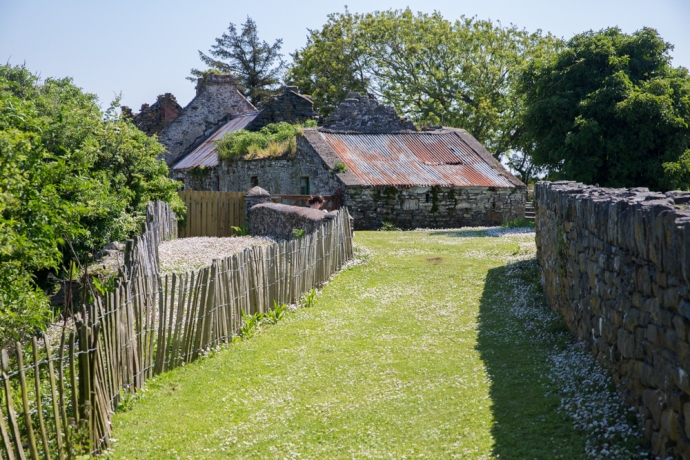
The Street. The village that housed pilots and their families from the early 1800s

The Street. Another view
Through the 20th century the population continued to decline especially after the pilots were transferred to the mainland in 1954. The last two residents eventually left the island in 1978. This fact somehow puts the whole story of the island into context. Its settlement is still in living memory.
There are many reminders of this time aside from the ruins of The Street and elsewhere. Many of the gravestones at Tempall Na Marbh, which although being the youngest of the churches on the island (14th or 15th century), are beautifully preserved. Many date from pre-famine time and contain symbolic representations that not only represent religious iconography but tell the story of residents lives. Though the church ceased to be operative centuries ago many descendants chose to be buried there and they still do today.

Beautifully engraved gravestone at Church of the Dead. Dating from 1828
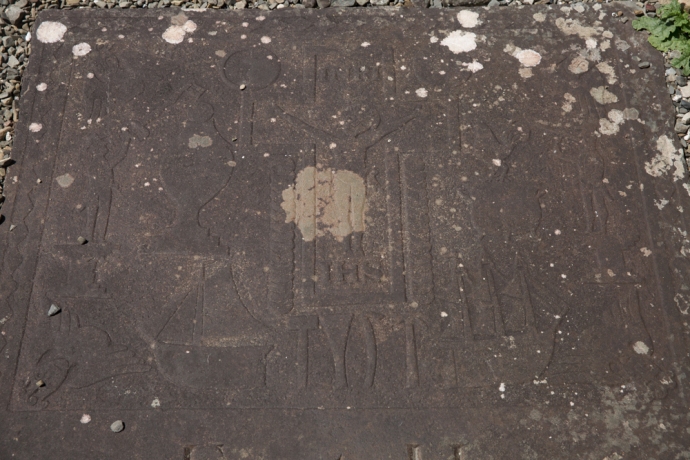
Engraved symbolic representations on a grave stone including images of a three masted ship and a hooker and perhaps shipwright’s tools. Presumably the deceased was a mariner.
Following the end of settlement the island lay empty for many years, This could have been the end of the story as the island eventually passed into the hands of a developer with grand plans for a marina. Luckily this came to naught and the island was eventually sold to a Belgian group. We owe an enormous debt of gratitude to a group of Kilrush residents who pushed hard to regain ownership and ultimately bought the island back. These residents still own the island and they ceded management to the State.
That is a great outcome. It is not hard to imagine that in years to come Scattery will become one the essential Irish monastery sites to visit; right up there with Glendalough and Clonmacnoise.
Put it on your agenda for your next visit.



